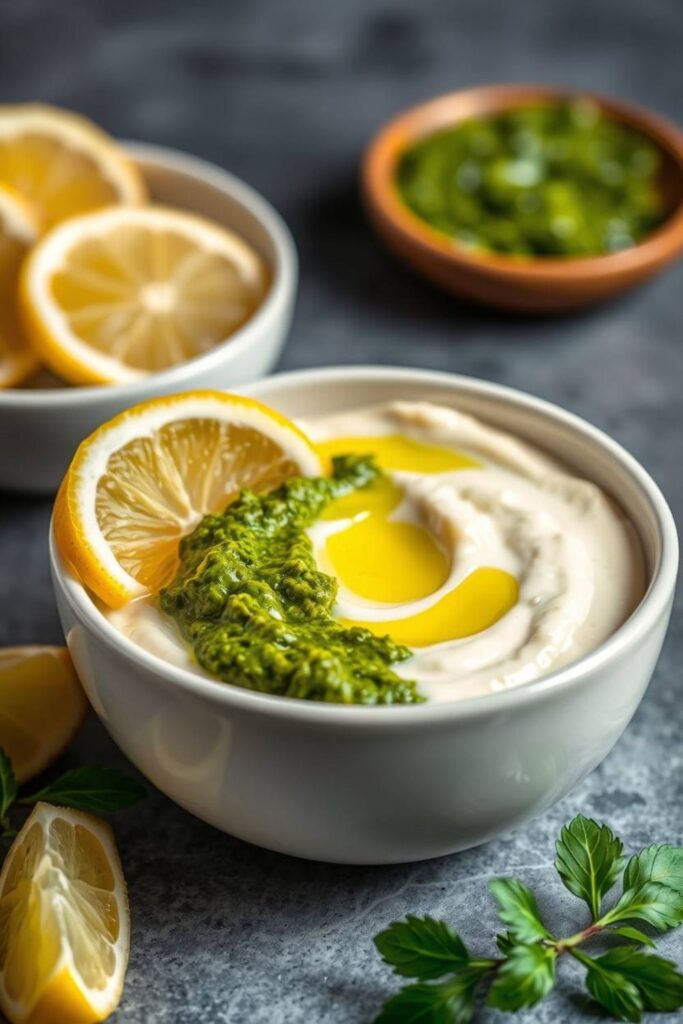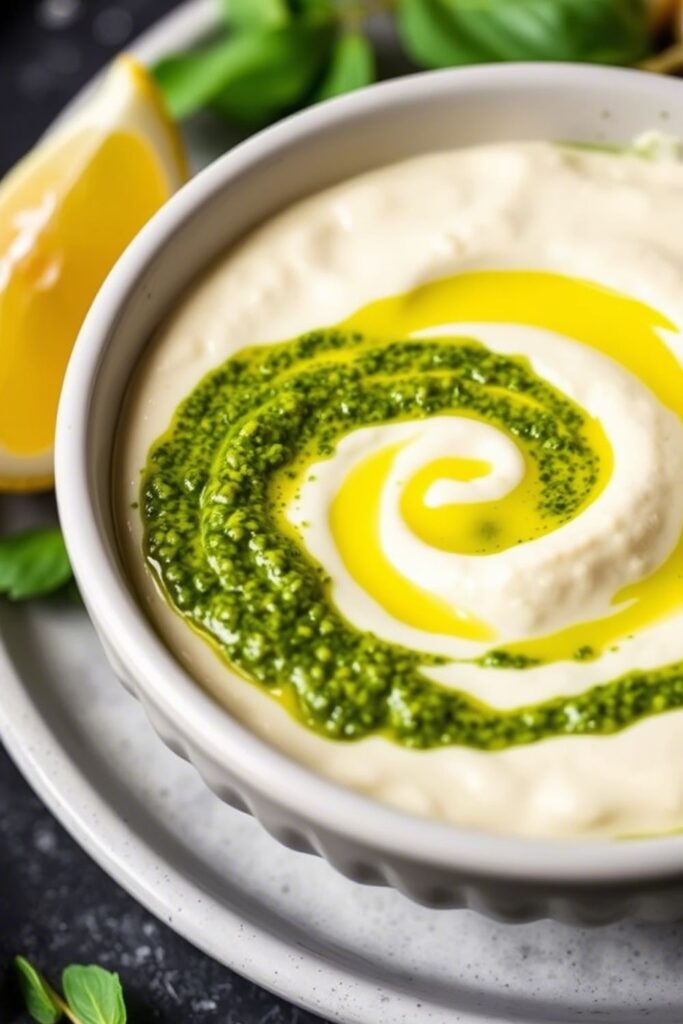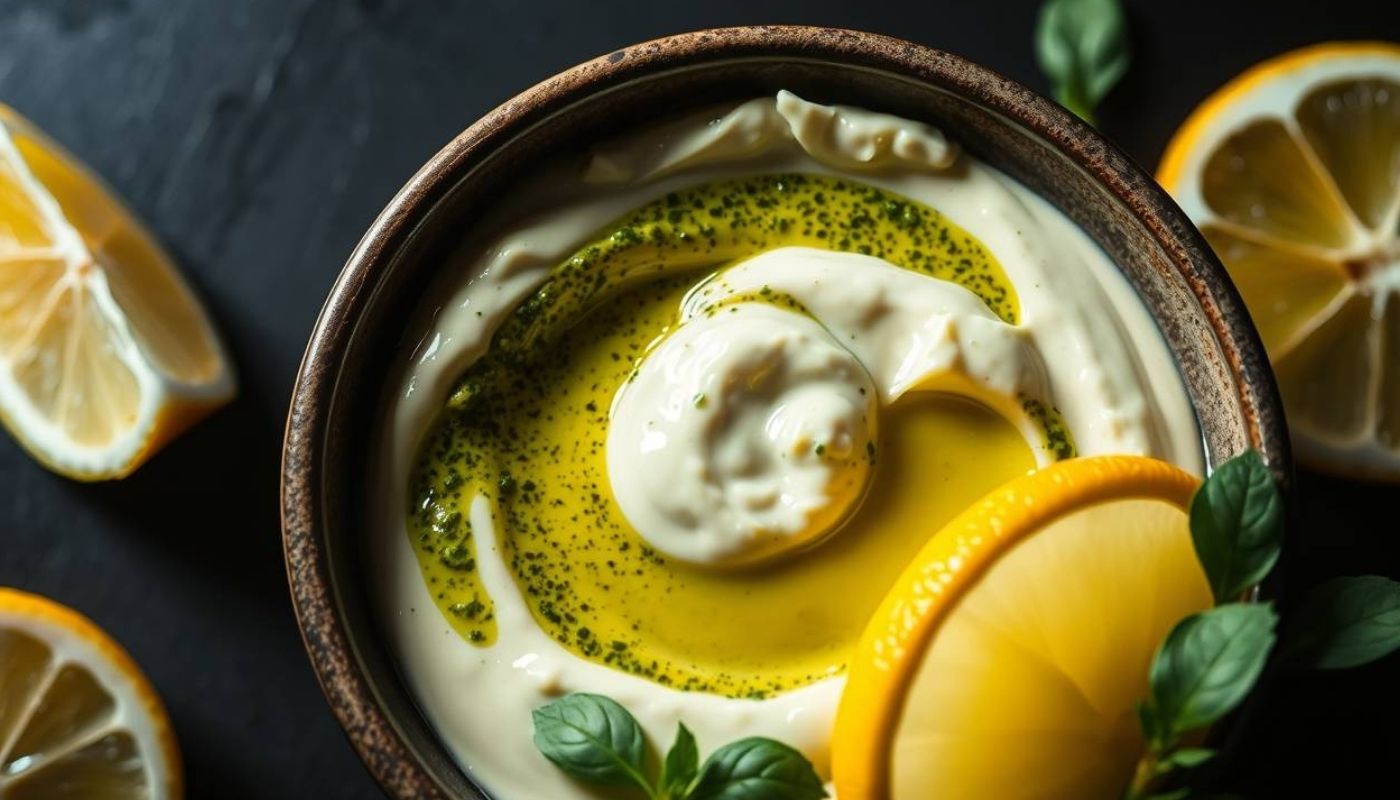Ever tasted something so creamy, garlicky, and herby that you had to pause mid bite? That’s what Pesto Aioli does. It stops time. It wakes up taste buds. And yep once you try this Pesto Aioli recipe, you’re gonna wonder how your sandwiches, roasted veggies, or crispy fries ever survived without it.
So, what is it exactly? Imagine the boldness of fresh basil pesto meeting the silky richness of homemade aioli. Now swirl them together. That’s magic in a bowl. This Pesto Aioli recipe isn’t just a sauce, it’s the flavor upgrade your meals have been begging for.
In this post, we’ll walk through every step of making it from scratch. No stress. No fancy equipment. Just simple ingredients, clear steps, and a little kitchen know how. I’ll share tips, smart swaps, and one sneaky trick that makes this Pesto Aioli recipe extra smooth.
Get ready. You’ll learn how to balance flavor, avoid common mistakes, and serve it like a pro. Stick around, because this creamy green wonder is about to become your go to secret weapon.
Ingredients & Substitutions
Fresh Basil Leaves: 2 cups fresh basil leaves, packed. Choose only the freshest basil available, preferably Genovese variety. The leaves should be bright green without any dark spots or wilting. Substitute spinach leaves for color if fresh basil isn’t available. Avoid dried basil entirely, it simply won’t work for this application.
Garlic Cloves: 4 large cloves Fresh garlic provides the backbone of authentic aioli. Choose firm, plump cloves without green sprouts. Blanch garlic in boiling water for thirty seconds for milder flavor. Garlic sensitive people can reduce to two cloves or use roasted garlic.
Pine Nuts: 1/3 cup, toasted Traditional Pignoli pine nuts offer the best flavor, but they’re expensive. Walnuts or blanched almonds make excellent substitutes and actually provide more body to the sauce. Toast nuts lightly in a dry pan until fragrant.
Parmesan Cheese: 1/2 cup Parmesan cheese, freshly grated. Choose authentic Parmigiano Reggiano aged at least twenty four months. The crystallization and depth of aged cheese is irreplaceable. Pecorino Romano works as a substitute but will make the sauce sharper and more aggressive. Never use pre grated cheese from a container, it lacks the oils that bind the sauce properly.
Egg Yolks: 2 large, room temperature Room temperature yolks emulsify much easier than cold ones. Place whole eggs in warm water for five minutes. For food safety concerns, pasteurized eggs work perfectly, though traditional French chefs might scoff.
Extra Virgin Olive Oi: 3/4 cup Choose fruity, medium intensity oil rather than peppery varieties. The oil’s flavor will be prominent in the finished sauce.Spanish Arbequina or Italian Taggiasca olives work beautifully. For a more neutral flavor profile, you can substitute light olive oil.
Fresh Lemon Juice: 2 tablespoons Freshly squeezed lemon juice is non negotiable. The citric acid helps stabilize the emulsion while brightening all the other flavors. White wine vinegar can substitute in a pinch, though you’ll lose some brightness.
Sea Salt: 1 teaspoon, or to taste Fine sea salt dissolves more readily than kosher salt. Start conservatively, you can always add more, but you can’t take it back.
Step by Step Instructions for Pesto Aioli Recipe

Prepare Your Workspace Set all ingredients at room temperature 30 minutes before starting. This prevents emulsion breaks later. Have a kitchen towel ready to stabilize your mixing bowl, a broken aioli is a heartbreaking thing to watch.
Toast the Pine Nuts Heat a dry skillet over medium low heat. Add pine nuts and toast for 2-3 minutes, stirring constantly. They’ll go from golden to burned in seconds, so watch carefully. Let them cool completely before proceeding.
Create the Pesto Base Combine basil leaves, garlic, toasted pine nuts, and Parmesan in a food processor. Pulse in short bursts to avoid overheating basil. Scrape down sides frequently. The mixture should be roughly chopped, not completely smooth.
Begin the Aioli In a separate bowl, whisk egg yolks with lemon juice and a pinch of salt. This acidic environment helps stabilize the coming emulsion. Start whisking vigorously and begin adding olive oil drop by drop. I cannot stress this enough, patience here determines success or failure.
Build the Emulsion After adding about 1/4 cup of oil drop by drop, the mixture should thicken noticeably. Now you can increase to a thin stream while whisking continuously. If it starts looking grainy or separated, stop immediately and fix it with a tablespoon of warm water whisked in vigorously.
Combine Pesto and Aioli Once your aioli holds its shape on the whisk, fold in the pesto mixture gradually. Don’t use the food processor now, it will break the delicate emulsion you’ve worked so hard to create. Fold gently with a rubber spatula until just combined.
Season and Adjust Taste carefully and adjust seasoning. You might need more lemon juice for brightness or salt for depth. The sauce should coat the back of a spoon but still flow smoothly.
Cooking Techniques & the Science Behind the Pesto Aioli Recipe
Understanding emulsification is crucial for Pesto Aioli Recipe success. You’re essentially forcing oil and water based ingredients to stay together permanently—something they naturally resist. The lecithin in egg yolks acts as an emulsifier, surrounding oil droplets and keeping them suspended in the water phase.
Temperature control matters enormously. Cold ingredients resist emulsification, while hot ingredients can cause the proteins in egg yolks to coagulate, breaking your sauce instantly. Room temperature creates the perfect environment for stable emulsion formation.
The mechanical action of whisking creates millions of tiny oil droplets. Consistent, vigorous whisking ensures these droplets stay uniformly small and stable. Stop whisking, and larger droplets form, eventually leading to separation.
Adding acid first serves multiple purposes. It partially denatures the egg proteins, making them more effective emulsifiers. The acid also provides insurance against bacterial growth and adds essential brightness to balance the rich oil.
Traditional mortars and pestles actually produce a better pesto texture than food processors. The grinding action tears cell walls more gently than steel blades, preserving more essential oils and preventing bitterness. If you have the time and arm strength, try it—the difference in your Pesto Aioli Recipe is remarkable.
Serving & Pairing Suggestions

Pesto aioli transforms simple grilled proteins into restaurant quality dishes. Dollop it alongside grilled salmon, where the herbaceous notes complement the fish’s natural oils beautifully. The sauce also elevates roasted vegetables, try it with charred asparagus or roasted fingerling potatoes.
For elegant presentation, use a squeeze bottle to create artistic dots around the plate. The vibrant green color provides stunning contrast against white plates or dark proteins. A light drizzle over burrata creates an impressive appetizer that requires minimal effort.
Bread applications are endless. Spread it on focaccia for sophisticated sandwiches, or serve as a dip with grilled pita. It transforms ordinary chicken salad into something special when used as the binding agent instead of plain mayonnaise.
Wine pairings should complement both the herbaceous basil and rich aioli base. Crisp white wines like Vermentino or Sancerre work beautifully. For reds, choose something light like Chianti Classico, the acidity cuts through the richness perfectly.
The sauce keeps well in refrigeration for up to one week, though the basil may darken slightly. Bring to room temperature before serving, as cold temperatures dull the flavors and thicken the consistency.
Conclusion
This pesto aioli recipe represents the heart of Mediterranean cooking where simple, quality ingredients are transformed into something extraordinary. The magic lies in mastering emulsification while staying true to bold, traditional flavors.
With this sauce in your repertoire, you have a flavor packed secret weapon that instantly elevates any dish. Its vibrant green hue draws attention, while the creamy, garlicky depth leaves everyone wondering what makes it so unforgettable. It’s proof that culinary brilliance often begins with a happy accident in a busy kitchen.
Remember, mastering the pesto aioli recipe takes practice. Even seasoned chefs occasionally split a batch. But over time, the process becomes second nature until you can whip up flawless pesto aioli by instinct alone
Frequently Asked Questions about Pesto Aioli Recipe
Can I make pesto aioli ahead of time?
Yes, pesto aioli keeps well refrigerated for up to one week. Store it in an airtight container and bring to room temperature before serving. The flavors actually improve after a day as they meld together.
What should I do if my aioli breaks or separates?
Don’t panic, broken aioli can usually be fixed. Start with a fresh egg yolk in a clean bowl, then slowly whisk in the broken mixture. Alternatively, try whisking in a tablespoon of warm water or mustard to re establish the emulsion.
Can I use a food processor instead of whisking by hand?
While possible, hand whisking gives you better control over the emulsion process. If using a food processor, add oil extremely slowly through the feed tube while the machine runs continuously. The texture will be slightly different but still delicious.
Is there a vegan version of pesto aioli?
Absolutely! Replace egg yolks with aquafaba (chickpea liquid) or use a high quality vegan mayonnaise as your base. The process remains the same, though the flavor will be slightly different without the richness of egg yolks.
Why does my pesto turn brown after making it?
Basil oxidizes quickly when exposed to air, similar to how apples brown. To prevent this, blanch basil leaves in boiling water for 10 seconds, then shock in ice water before processing. This preserves the bright green color for days.

Swiftly Captions by Tina Smith — Quick, flavorful food recipes made simple, bringing fresh inspiration to your kitchen every day






